| Eero Järnefelt | |
|---|---|
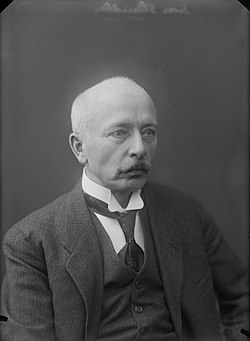 | |
| Born | Erik Nikolai Järnefelt (1863-11-08)8 November 1863 Viipuri, Grand Duchy of Finland |
| Died | 15 November 1937(1937-11-15) (aged 74) Helsinki, Finland |
| Nationality | Finnish |
| Known for | Painter |
Erik "Eero" Nikolai Järnefelt (8 November 1863 – 15 November 1937) was a Finnish painter and art professor. He is best known for his portraits and landscapes of the area around Koli National Park, in the North Karelia region of Finland. He was a medal winner at the Paris Exposition Universelle of 1889 and 1900, taught art at the University of Helsinki and was chairman of the Finnish Academy of Fine Arts.
Biography
He was the son of General Alexander Järnefelt and Baroness Elisabeth Järnefelt (née Clodt von Jürgensburg). He came from a Swedish-speaking Finnophile family of artists, writers and composers descended from the Baltic aristocracy. Several of his eight siblings also became well-known: Kasper [fi] (a literary critic), Arvid (a judge and writer), Armas (a composer and conductor) and Aino (wife of Jean Sibelius).

After graduating from a private academy, he studied at the Academy of Fine Arts, Helsinki from 1874 to 1878, the Imperial Academy of Arts from 1883 to 1886 (where one of his teachers was his uncle, Mikhail Clodt), and the Académie Julian in Paris from 1886 to 1888, where he studied with Tony Robert-Fleury. A major influence was the Naturalism of Jules Bastien-Lepage.
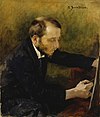

In 1889, he married the actress Saimi Swan [fi]. In 1892, he made his first trip to the area around Koli with Juhani Aho and his wife, the painter Venny Soldan-Brofeldt. He was impressed with the scenery there and would continue to visit regularly until 1936.
In 1893, he traveled to Finland where he sketched and photographed agricultural workers which inspired his most famous painting, Under the Yoke (Burning the Brushwood). Later, he made several study trips; to Italy in 1894 and Crimea in 1899. That same year, he helped organize an international exhibition in Saint Petersburg, sponsored by Mir Iskusstva.
In 1901, he built a home that he named "Suviranta" (Summer Beach) at the artists' colony near Lake Tuusula, designed by Usko Nyström. He lived there only until 1917 when he moved to Helsinki, but it is still owned and used by his family.
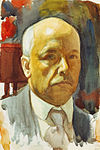
From 1902 to 1928, he taught drawing at the University of Helsinki. He was appointed professor there in 1912 and served as chairman of the Finnish Academy of Fine Arts. His last major work was an altarpiece for the church in Raahe, which he completed in 1926. A major retrospective was held in 2013, which included several previously unknown works.
Selected paintings

-
 Berry Pickers, 1888
Berry Pickers, 1888
-
 French Wine Bar, 1888 (fi)
French Wine Bar, 1888 (fi)
-
 Laundry at the River Bank, 1889 (fi)
Laundry at the River Bank, 1889 (fi)
-
 Summer Night Moon, 1889 (fi)
Summer Night Moon, 1889 (fi)
-
 Cows in Turf Smoke, 1891 (fi)
Cows in Turf Smoke, 1891 (fi)
-
 Saimi in the Meadow, 1892
Saimi in the Meadow, 1892
-
 Householder and the Farmhands, 1893
Householder and the Farmhands, 1893
-
 Great Crested Grebe, unknown date
Great Crested Grebe, unknown date
-
 Under the Yoke (Burning the Brushwood), 1893 (fi)
Under the Yoke (Burning the Brushwood), 1893 (fi)
-
 Pond Water Crowfoot and Shorestones, 1895 (fi)
Pond Water Crowfoot and Shorestones, 1895 (fi)
-
 Falcons in the Forest, 1895
Falcons in the Forest, 1895
-
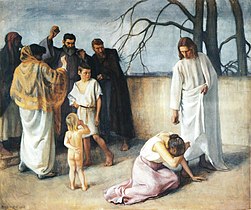 Jesus and the Sinful Woman, 1908 (fi)
Jesus and the Sinful Woman, 1908 (fi)
-
 Lake Shore with Reeds, 1905 (fi)
Lake Shore with Reeds, 1905 (fi)
-
 Girl with a Dog, 1910
Girl with a Dog, 1910
-
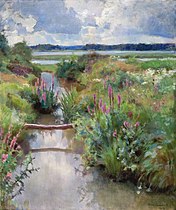 Blooming Summer, 1918
Blooming Summer, 1918
-
In a Storm with Jesus, 1926
-
 Conversion of Paul the Apostle, 1932
Conversion of Paul the Apostle, 1932
-
 Johan Philip Palmén [fi], 1890
Johan Philip Palmén [fi], 1890
-
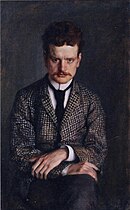 Jean Sibelius, 1892
Jean Sibelius, 1892
-
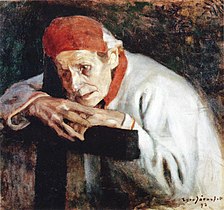 Larin Paraske, 1893
Larin Paraske, 1893
-
 Portrait of the Artist's Son, 1897
Portrait of the Artist's Son, 1897
(Heikki Järnefelt [fi] (1891–1963)) -
 Nelma, 1899
Nelma, 1899
(Nelma Sibelius [fi]) -
 Leena, 1903
Leena, 1903
(Leena Järnefelt (1897–1991)) -
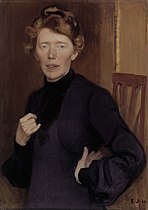 Tekla Hultin, 1905
Tekla Hultin, 1905
-
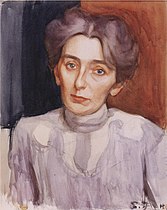 Aino Sibelius, 1908
Aino Sibelius, 1908
-
 Juho Kusti Paasikivi, 1931
Juho Kusti Paasikivi, 1931
-
 Carl Gustaf Emil Mannerheim 1933
Carl Gustaf Emil Mannerheim 1933
-
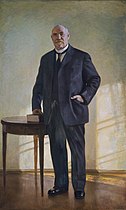 Pehr Evind Svinhufvud, 1933
Pehr Evind Svinhufvud, 1933
-
 Children playing, 1895
Children playing, 1895
See also
Notes
- Altar painting, located in Lieto Church [fi].
- Altar painting, located in Raahe Church [fi]. Järnefelt himself would have preferred the name Awakening of Hope.
- Altar painting, located in St. John's Church, Helsinki.
References
- Konttinen, Riitta (20 April 2016). "Järnefelt, Eero (1863 - 1937)". Kansallisbiografia. Retrieved 22 August 2020.
- Littorin, Pauliina (3 September 2019). "Eero Järnefelt luotti klassiseen tyyliin – parhaat teokset vaihtavat omistajaa, kun talous porskuttaa". Taloustaito. Retrieved 22 August 2020.
- "Elämäkerta Eero Järnefelt 1863–1937". Eero Järnefeltin seura r.y. Retrieved 22 August 2020.
- Biography and appreciation Archived 2003-02-27 at the Wayback Machine @ Kultakausi.
- Sarajas-Korte, Salme (2003). "Järnefelt, Eero". Grove Art Online. Retrieved 24 March 2020.
- ^ Brief biography @ Kansallisbiografia.
- Murphy, Adrian (January 21, 2020). "Eero Järnefelt, painter of Finnish nature". Europeana. Retrieved 22 August 2020.
- "Under The Yoke: The Story of Poverty (and Progress) Behind a Masterpiece" Foundation for Economic Education. Retrieved 2023-05-14.
- Suviranta Archived 2012-07-20 at the Wayback Machine @ Ainola.
- "Classics on tour: Eero Järnefelt's Under the Yoke (Burning the Brushwood), 1983". jyvaskyla.fi. Retrieved 22 August 2020.
Further reading
- Pontus Grate and Nils Göran Hökby, ed. 1880-tal i nordiskt måleri (exh. cat., Stockholm: Nationalmuseum, 1985) ISBN 9789171002822
- Leena Lindqvist (ed.), Taiteilijan tiellä – Eero Järnefelt 1863–1937 (The Artist's Path), Otava, 2002 ISBN 951-1-144-66-9
- Marko Toppi (ed.), Eero ja Saimi Järnefeltin kirjeenvaihtoa ja päiväkirjamerkintöjä 1889–1914 (correspondence and diaries, vol.1), SKS, 2009 ISBN 978-952-222-113-1
- Marko Toppi (ed.), Vain tosi on pysyväistä. Eero ja Saimi Järnefeltin kirjeenvaihtoa ja päiväkirjamerkintöjä 1915–1944 (correspondence and diaries, vol.2), SKS, 2013 ISBN 978-952-222-399-9.
- Kirk Varnedoe, ed. Northern Light: Realism and Symbolism in Scandinavian Painting, 1880–1910 (exh. cat., New York, Brooklyn Museum of Art, 1982) ISBN ISBN 9780872730946
- Ludwig Wennervirta: Eero Järnefelt, ja hänen aikansa 1863–1937 (Helsinki: Otava, 1950)
External links
- Arcadja Auctions: More works by Järnefelt
- Finnish 10 Euro Coin (2013) honoring Eero Järnefelt @ the Mint of Finland
- Europeana blog, from January 2020